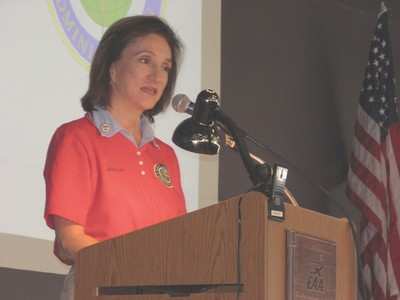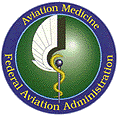Text Of FAA Administrator Marion Blakey's "Meet The
Administrator" Speech
Editor's Note: Below is the full, unedited
text of FAA Administrator Marion Blakey's opening speech Wednesday
to attendees of the annual "Meet The Administrator" -- formerly
"Meet The Boss" -- forum at AirVenture 2006.

Aero-News has COMPLETE audio coverage of the event -- as
well as the subsequent Q&A session -- available here. You may also read our
commentary on the forum here.
****
Thanks, Tom [Poberezny]. And thank you all for taking the time
to meet with me. You know, I look forward to coming here every
year. In fact, this makes four in a row. I’ve said it before,
and I’ll say it again. If you haven’t been to Oshkosh,
you don’t know GA. And if you don’t know GA, you
don’t know aviation. 700,000 people. 12,500 aircraft. 18,000
campers a night. 100,000 people per day. And countless dreams.

Let me tell you, when Orville and Wilbur took off, I’ve
got to think that this is what they had in mind. Acres and acres of
airplanes. Row after row of some spectacular flying machines. Tom,
I don’t think the Wrights expected tailgate parties under the
wings, but progress is progress.
Before we get going, I’d like the members of my management
team who are with me here today to stand up and introduce
themselves. All right, thank you.
It’s also my pleasure to introduce another group of
all-stars. As many of you know, the General Aviation Awards Program
and the FAA have recognized a small group of aviation professionals
for their contributions to aviation safety and education.
This awards program is a cooperative effort between the FAA and
industry. The selection process begins at the FSDOs and then moves
on to the nine regional FAA offices. Panels of aviation
professionals within the various fields then select national
winners from the pool of regional awardees.
 The envelope, please.
This year’s recipients are CFI of the Year Rich Stowell of
Ventura, California; aviation safety counselor of the year Gene
Hudson of Mission Hills, California; aviation maintenance
technician of the year Joe Hawkins of Murfreesboro, Tennessee; and
avionics technician of the year Terry Markovich of Bedminster, New
Jersey.
The envelope, please.
This year’s recipients are CFI of the Year Rich Stowell of
Ventura, California; aviation safety counselor of the year Gene
Hudson of Mission Hills, California; aviation maintenance
technician of the year Joe Hawkins of Murfreesboro, Tennessee; and
avionics technician of the year Terry Markovich of Bedminster, New
Jersey.
I hope you can come to the Theater in the Woods where the awards
will be presented formally. Gentlemen, congratulations. OK now,
let’s get going.
Let me start with a hot button. I came to the FAA on September
13, 2002. My approach from the get-go was to listen to what the
stakeholders have to say. For those of you who’ve been
following our strategic plan — the Flight Plan — you
know that we’ve opened up our books to anyone who wants to
look. We asked you what’s important, you told us, and we
incorporated those thoughts into our marching orders. And we post
our progress on the web every month.
With that said, last year’s Meet the Administrator session
brought quite a bit of heat when the subject turned to medicals.
Truth be told, that’s been drawing a lot of attention for
several years, even before I got here. But there is good news. You
wanted the Federal Air Surgeon to modify the medical certification
system to reduce delays airmen were experiencing in the issuance of
medical waivers. That’s just what we did. We’ve been
making changes incrementally for quite some time, and the IT
investment — handling these electronically — is paying
off.
The changes we’ve made have reduced the average waiting
time for a special issuance waiver from several months to 16 days.
Now, averages are just that — an average — and some of
you have likely waited longer than the average to get your
certificate. That’s because we do continue to see some very
complex cases that require analysis and expert judgment.
But more than 90 percent of the pilots who walk through the
Aviation Medical Examiner’s door get their medicals on the
spot. The other 10 percent now are looking at what’s
essentially a two-week wait. And that’s as it should be. So,
how did we do it?
Nick Sabatini, Fred Tilton, Tom Poberezny, Earl Lawrence,
Richard Jennings and Jack Hastings took a look at a list of ideas
on how to make this problem a thing of the past. The EAA medical
advisory committee got together to review the changes.

Specifically, we convened groups of FAA flight surgeons to
process cases in the queue for review. This reduced the backlog
immediately. Other groups will be convened whenever necessary to
deal with future backlogs. We modified the system so that most
cases can be reviewed electronically instead of manually. We also
made it so that the regions can work cases that previously could
only be worked by the Aerospace Medical Certification Division in
Oklahoma.
We expanded the aviation medical examiner assisted special
issuance process that allows the AME to issue waivers for specific
medical conditions. We increased it from 20 conditions to 35
conditions — renal cancer, melanoma, bladder cancer, heart
attacks, bypass surgery, to name a few. We also actively pursued
the EAA and other associations to encourage AMEs to participate in
the special issuance process.
We didn’t stop there. We started a rulemaking that will
propose to extend the interval for first-class medical
certification from six months to one year. For third-class medicals
for pilots under 40 — from 2 years to 5 years. These two
interval changes are consistent with the changes that ICAO is
making. It is estimated that these two changes will reduce annual
applications by 75,000 and therefore provide better, quicker
service to others
So how’s it going? Let me quote from an email from
Doctor Hastings at the EAA to Doctor Tilton at the FAA:
“I really would like the world to know that we have dedicated
people in the [FAA’s] Office of Aviation Medicine who do
their darnedest to make things better for the aviator.”
That’s the kind of endorsement that makes a public servant
proud. We got to this place because when you spoke, we listened.
Tom, we’ve come to count on EAA for sound recommendations,
and you came through. You know, we certify about 450,000 pilots per
year. The goal is to get better than 30 days and maintain it.
We’re there. But I promise you we’re pushing to get
better.

Let me turn now to a broader issue. It’s the one we always
come back to — safety. As you know, there’s been a
significant reduction in general aviation fatal accidents.
That’s a tip of the hat to you because as we all know safety
begins with you.
The trend is pointed in absolutely the right direction. There
were 124 general aviation fatal accidents during the first six
months of the year, 22 fewer fatal accidents than during the first
six months of last year. The number of fatal amateur-built aircraft
accidents is also down considerably this year, from 28 to 18.
The numbers are good in Alaska as well, where we’ve had a
significant reduction in accidents. There were 40 accidents in
Alaska during the first six months of the year, versus 51 last
year. Four were fatal. More than two-thirds of these accidents
resulted in no injuries. In many of these accidents, the rugged
operating environment is a factor, particularly landing on
unimproved surfaces. That’s a daily activity in Alaska, where
GA obviously has a vital role.
That’s good news. That’s better than good news.
That’s what happens when government and stakeholders push
together. The FAA has partnered with industry in the General
Aviation Joint Steering Committee to analyze accident trends and
recommend interventions. This government-industry group is taking a
data-driven approach to identify what we can do to prevent GA
accidents — a scientific approach. They’re asking the
questions: What’s the data telling us? And maybe
more importantly, what’s the smartest thing we can do with
it?
We know from the numbers that weather, loss of control and
aeronautical decision-making are the leading causes of fatal GA
accidents. We addressed these factors in a “FAA Common Safety
Challenges” document emailed to over 200,000 pilots last
September. How many of you received it? We’ve also put
an electronic library of safety information on line at www.faasafety.gov.
Remember, we’re not expecting overnight success. But as we
chip away at the things that cause problems, we push the trend
arrow in the right direction.
Because GA is so diverse, there are no general solutions to
reduce accidents. There is no one size fits all. That’s where
groups like this one come in. You’ve never been reluctant to
share ideas, and I’m expecting that today will be no
different. So, accept my congratulations on that safety record.
You’ve earned it. Collaboration. Training. Add one to the
other and you’ve got the makings of a safe flight.
You know, looking at the safety record, not just in GA but
commercially as well, it’s clear that we’re at a
turning point. Very light jets, microjets, whatever label you might
put on them, we think that this is a market that shows real
promise. This morning, I got a firsthand look at the Diamond D Jet.
Tomorrow, the Eclipse 500. By the year 2017, we anticipate that
there will be 5,000 very light jets in service.
It’s easy to look at these new breeds and make the
presumption that the status quo for safety will naturally extend
itself. We’re making sure that the steps we take will assure
that they’re safe to use and that they’re used
safely.
 We’re working
collaboratively with the VLJ manufacturers in developing new
training programs. While traditional training programs were more
maneuver-based, our newer programs use the FAA/Industry Training
Standards approach. For those of you who know the acronym,
it’s called FITS. It places greater emphasis on using
scenario-based training to develop the pilot's aeronautical
decision making, risk management and single-pilot resource
management skills. It’s an old saying, but it’s still
true: train the way you fly, and fly the way you train.
We’re working
collaboratively with the VLJ manufacturers in developing new
training programs. While traditional training programs were more
maneuver-based, our newer programs use the FAA/Industry Training
Standards approach. For those of you who know the acronym,
it’s called FITS. It places greater emphasis on using
scenario-based training to develop the pilot's aeronautical
decision making, risk management and single-pilot resource
management skills. It’s an old saying, but it’s still
true: train the way you fly, and fly the way you train.
Inspections. We’re working to ensure both maintenance and
operations inspectors are adequately trained and that it’s
timely as well. We’re training controllers about the
capabilities of these new aircraft, which are slower on approach
than most jets.
I’m equally pleased to report that light sport aircraft
continue to show an enthusiastic response. Since I saw you last,
the LSA market has seen extraordinary growth. What a difference a
year makes. Now, over 36 different companies are manufacturing and
delivering these airplanes. Several manufacturers have reported
that their 2006 production lines are totally sold out. According to
our Aircraft Registry, over 378 new factory-built aircraft have
received special light sport aircraft airworthiness certificates.
Cessna’s in the game too. They recently announced their
“proof of concept” light-sport airplane. I want you to
know that we’re working hard to get the infrastructure in
place to handle the surge in light sport aircraft. I’m
looking forward to hearing stories from you who’re going to
be taking us up on it.
As you can see, there’s an awful lot going on. And with
all of this said you have my firm commitment that we’re
working to spend your taxpayer dollar as wisely as possible. Last
year, I spoke to you about operating more like a business. That
continues to be a priority.
And as I close, I’d like to talk about the big picture
— the importance of system modernization and financing
reform. Right out of the box, there’s no question that
general aviation in the United States is more vibrant than anywhere
else in the world. Equally without doubt is the simple fact that GA
plays a vital role in the U.S. economy.
As you know, we are projecting demand for aviation — both
commercial and noncommercial — to grow by 2-3 times over the
next 20 years. We also know that the system as it exists now cannot
handle such growth. We must increase the capacity of the system.
Without modernization, congestion will increase and the entire
aviation community will suffer. In the GA community, pilots would
lose the flexibility and enjoyment of flying. It would be more
difficult to gain access to the aviation system when and where a
pilot wants it. Growth — and the jobs and economic benefits
that come with it — would be constrained. That’s a
world that nobody wants to be in.
Fortunately, we have an opportunity to transform the NAS into a
next generation system while we increase efficiency and capacity.
All of the major user groups — NBAA, AOPA, GAMA, EAA —
support modernization and have a common interest in pursuing
it.
Supporting it is the easy part. Paying for it is another matter.
In order to develop and deploy the Next Generation System in the
most efficient way possible, we need to change how the aviation
system is financed. In other words, our revenues need to tie to the
agency’s costs. The opportunity to do so only comes every 10
years, and it is upon us with the current system expiring on
September 30, 2007.

This new funding system does not have to entail broad user fees
for general aviation. There are multiple ways to recover a given
amount of costs, and we do not believe that a “one size fits
all” solution is necessary. While it is important that each
group pay its fair share of the costs, let me be crystal
clear: we do not want to create a funding system that stifles
the GA community.
We have also heard your suggestion that there should be a
healthy general fund contribution to recognize the value that the
aviation system brings to the general public, even those who
don’t fly. We strongly support a continued general fund
contribution.
Finally, it is important to emphasize that under any financing
structure, Congress will continue to play a significant oversight
role. We want to work with the GA community and your
representatives in Congress to reform the financing system in a way
that facilitates modernization and allows GA to continue to
thrive.
I’m confident that we’ll do just that. The number of
people in this room — the number of people at this show
— is an indication that general aviation is important to
America. I’m looking forward to working with you so that it
stays that way. Thank you.
 ANN's Daily Aero-Linx (04.13.24)
ANN's Daily Aero-Linx (04.13.24) ANN's Daily Aero-Term (04.13.24): Beyond Visual Line Of Sight (BVLOS)
ANN's Daily Aero-Term (04.13.24): Beyond Visual Line Of Sight (BVLOS) Airborne 04.09.24: SnF24!, Piper-DeltaHawk!, Fisher Update, Junkers
Airborne 04.09.24: SnF24!, Piper-DeltaHawk!, Fisher Update, Junkers Aero-News: Quote of the Day (04.14.24)
Aero-News: Quote of the Day (04.14.24) ANN's Daily Aero-Term (04.14.24): Maximum Authorized Altitude
ANN's Daily Aero-Term (04.14.24): Maximum Authorized Altitude









